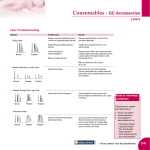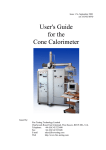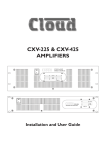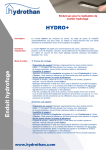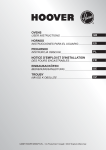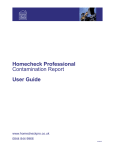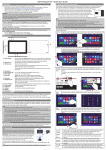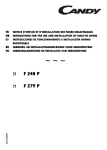Download Draft determination consultation document
Transcript
Draft Determination of an Application for an Environmental Permit under the Environmental Permitting (England & Wales) Regulations 2010 Consultation on our decision document recording our decision-making process The application reference number is: E3/1/156 The Applicant is: Egan Tyre & Plastic Recycling Limited The Installation is located at: Byass Works, Dock Road, Port Talbot, SA13 1RS. Type of proposed installation: Small Waste Incineration Plant Consultation commences on: 29 September 2015 Consultation ends on: 28 October 2015 What this document is about This is a draft decision document, which explains how we have considered the Applicant’s application, and why we are proposing not to issue a permit. The document is in draft at this stage, because we have yet to make a final decision. Before we make this decision we want to explain our thinking to the public and other interested parties, to give them a chance to understand that thinking and, if they wish, to make relevant representations to us. We will make our final decision only after carefully taking into account any relevant matter raised in the responses we receive. Our mind remains open at this stage: although we believe we have covered all the relevant issues and reached a reasonable conclusion, our ultimate decision could yet be affected by any information that is relevant to the issues we have to consider. However, unless we receive information that leads us to reconsider this draft decision, then we will refuse the application. Recommendation made by: Signed : …………… Date: 29/9/2015 Martin Hooper – Pollution Control Officer Signed : …………… Date: 29/9/2015 Loku Ranasinghe – Pollution Control Officer Recommendation approved by: Signed : …………… Nicola Pearce – Head Of Planning Date: 29/9/2015 Egan Tyre & Plastics Recycling Limited Permit Draft Determination Legislative background Local authorities by law must regulate certain types of factory and other activities. This is to reduce any pollution that they may cause and in particular to help to improve air quality. Businesses which operate these premises must have a permit. Local authorities decide whether to give a permit. If they do so, they must write down how the pollution is to be prevented and where this is not possible, minimised. In the law, the premises are known as “installations”. Some are called “part B” and local authorities can only deal with air pollution from them. Many different sorts of pollution are controlled at “A2” and SWIP installations. SWIP stands for Small Waste Incineration Plant. The Part B system is known as Local Authority Pollution Prevention and Control (LAPPC). The A2 and SWIP systems are known as Local Authority Integrated Pollution Prevention and Control (LA-IPPC). The types of installations which require a permit are defined within the Environmental Permitting Regulations 2010 and subsequent amendments. These regulations implement certain European Community Directives e.g. the Industrial Emissions Directive (IED). These regulations fall under the Pollution Prevention and Control Act, 1999. The operator must apply for a permit and pay a fee for doing so. The fee is to cover the regulator’s costs. The regulator must consider the application and decide whether it is “duly made”. For this to be the case, an application must include the fee, a completed application form and the necessary accompanying information. If any of these critical components are not present then the application is returned. If the application is “duly made” then the regulator must consult relevant members of the public and other organisations. If the regulator decides to issue a permit, it must include conditions. These conditions will say how pollution is to be prevented or minimised. The regulator must give consideration to any consultation responses and government guidance that may be available in writing permit conditions. If a regulator decides not to issue a permit, a business can appeal to Government. A business may also appeal if it receives a permit, but does not agree with any of the permit conditions. The specific Legislation and Guidance used in arriving at this particular decision are : • • • Industrial Emissions Directive – Chapters II and IV Environmental Permitting Regulations 2010 (as amended) Environmental Permitting Regulations -Schedule 13A • • Environmental Permitting General Guidance Manual on Policy and Procedures for A2 and B Installations (GGM) Reference Document on the Best Available Techniques for Waste Incineration- August 2006 ( BREF Notes) Background A visit to the site was conducted on 1st December 2014, at which time the plant was already installed. An application for a SWIP environmental permit was received from Egan Tyre & Plastics Recycling Limited on 19th December 2014. This application was refused on 6th January 2015 because it was considered to be not duly made as key information required in the application form was omitted. On 20th April 2015 a second SWIP application was submitted and the applicant was informed that it was considered to be duly made two days later. The application is for a Small Waste Incineration Plant (SWIP), in which waste tyres are pyrolysed to produce oil, char, steel and syngas. The tyres are heated in a sealed chamber (retort) in the absence of oxygen. Over time, the tyres are broken down producing a gas (syngas), some of which is used to heat the retort, the remainder being used to produce oil. At the end of the process, the retort will contain solid char, which can be used to produce carbon black, and steel from the tyre structure. The application is for a SWIP under Schedule 13a of the Regulations i.e. the incineration of non-hazardous waste at a rate of no more than 3 tonnes per hour. The plant is designed to process approximately 20 tonnes of tyres per day in three batches. A site visit was conducted on 8th May, where NPT officers met Dennis Egan and Daniel Egan. A note of the meeting is shown as Appendix 4. Consultation was carried out in accordance with guidance on 12th May. The following organisations were consulted: Natural Resources Wales, Health & Safety Executive, Local Health Board, Fire & Rescue Service and Food Standards Agency. Details were also placed on the Council website and notices were posted on lamp posts in the streets nearest the installation. A response was received from the Local Health Board, but no other responses were received from the organisations or the public. The first information notice was served on the applicant on 20th May with the response received on 10th June. A second information notice was served on 21st July and the response received on 7th August. A second site meeting was conducted on 21st August in order to clarify outstanding issues. Details of these can be found in Appendices 1, 2 and 3 respectively. The Determination Process In determining this permit application, the local authority should either grant a permit with conditions or refuse the application having regard to the legislation and statutory guidance (listed above). In both cases the local authority should give reasons for their decision. Environmental Permitting Regulations 2010 are found here : http://www.legislation.gov.uk/ukdsi/2010/9780111491423/contents Schedule 5, paragraph 13(1) of the regulations states that the regulator must refuse an application if the following criteria in paragraph 13(2) are not met. The applicant must: (a) be the operator of the regulated facility; and (b) operate the regulated facility in accordance with the environmental permit. The General Guidance Manual on Policy and Procedures for A2 and B Installations (GGM) is statutory guidance issued by DEFRA and has several paragraphs which elaborate on these requirements. It can be found here: https://www.gov.uk/government/collections/defra-guidance-on-local-authoritypollution-control-lapc-regime Each of the relevant points of this guidance is dealt with in turn below. Is the applicant the Operator? Section 6.22 of the GGM says that an application must be refused if the applicant will not be the operator of the permit. In this instance NPT is satisfied that the applicant will be the operator. Is the submitted information sufficient to determine permit conditions? Section 6.22 of the GGM says that an authority might refuse a permit … if the information provided by the operator does not provide a reasonable basis to determine permit conditions. At the time of writing there is insufficient information provided to write a permit, but it is conceivable that sufficient information might be provided in the fullness of time. Operator Competence and Management Systems Section 11.2 of the GGM states that local authorities must consider operator competence when assessing an application for a permit. This is dealt with in detail below. Section 11.3 of the GGM says that authorities must not issue a permit if they consider that the operator will not operate the installation in accordance with the permit. Authorities might doubt whether the operator would be likely to comply with permit conditions if: 1. The operator’s management systems are inadequate. 2. The operator’s financial competence is inadequate. 3. The operator has a poor record of compliance with previous regulatory requirements 4. The operator’s technical competence is inadequate. 1. Operator Management systems Section 11.23 of the GGM states that “Environmental management systems may be the means of demonstrating and maintaining technical competence. The competence of individuals should form part of those management systems”. The competence of individuals is discussed in detail in the “operator competence section” below. The working plan provided as part of the application is satisfactory in respect of the matters that it covers e.g. waste. However, it does not cover details relating to the operation of the pyrolyser. These details are to be provided in a user manual, but at present the only information available in this regard is a CE application document which is translated poorly from Chinese. This makes it difficult to understand how the process works and what steps are necessary in order to ensure that it is operated correctly. This document also outlines some of the maintenance requirements but is opaque in respect of the frequency of these checks. It is common practice for processes of this scale (e.g. cremators) to have external organisations such as the manufacturer provide the servicing and backup in the event of equipment failure. The fact that the manufacturer is based in China raises a question about the timely (or any) availability of this support. Daniel Egan (Jr.) has stated that they plan to apply for ISO 9001, but this is a quality system, whereas IS0 14001 or EMAS are environmental management systems which it is considered would be more suitable for dealing with a “high risk” installation such as the one applied for. The application advises that operators will be provided with one month of training by the Chinese supplier when the plant is commissioned. While training is of course welcome, there are significant concerns over the sufficiency of such training for an installation of this complexity. As a comparative example, it is necessary to complete a formal 6 month course with an exam in order to be permitted to operate a cremator, which is considered to be a less dangerous and complex piece of equipment than the pyrolyser proposed under this application. In this respect, evidence suggests that pyrolysis processes require a significant degree of skill to operate well (ref. Waste Incineration BREF Notes Table 4.9 page 239). If the process was very highly automated then in such circumstances the level of training requirements might be a little less important, however the CE application documentation shows that a very significant amount of operator intervention is necessary for this installation. This only reinforces the concerns in respect of the management systems. The site manager will have a WAMITAB qualification that is consistent with the requirements for handling waste. In concluding on Operator Management systems, it is considered that the company’s environmental management systems are inadequate having regard to considerations of the “risk” of the installation, with an ISO 9001 system not a sufficiently rigorous management system for such a “high risk” installation. It is considered that ISO 14001 or EMAS environmental management systems would be more appropriate. Moreover, it is considered that the suggested one month of training would not be sufficient to attain the requisite level of competence for an installation which requires a significant amount of skill to operate effectively. There is also uncertainty about the extent to which the manufacturer will be able to provide backup, as they are based in China and when the documentation provided to date is poorly translated and confusing. For reasons expressed later in this report under “operator technical competence section”, it is also considered that the operator does not currently demonstrate adequate technical competence because the individuals involved do not demonstrate adequate technical competence. 2. Financial competence The costs of installing continuous monitors and for extractive stack tests are considerable. An assurance has been provided by the operator that the costs of this and other works will be covered by Egan Waste. There is considered to be no reason to doubt this. 3. Compliance with previous regulatory requirements Section 11.24 of the GGM says that “In assessing operator competence authorities may consider whether the operator or any other relevant person has been convicted of relevant offences. A relevant offence is any conviction for an offence relating to the environment or environmental regulation.” The operator is Egan Tyre & Plastics Recycling Limited. There are two Directors of the Company namely: Mr Daniel Egan (DOB 06/04/1967) of 46 Eversley Road, Sketty, Swansea, SA2 9DA who made the the Environmental Permit application, was appointed a Director of Egan Tyre & Plastic Recycling Ltd on the 21st March 2014. Mr Daniel Egan (DOB 6/12/1946) of 95 High Street, Gorseinon, Swansea, SA4 4BL, appointed Director of Egan Tyre & Plastics Recycling Limited on 1st September 2014. “Relevant Person” Section 11.25 of the GGM defines a “relevant person” as: o The operator o A director, manager, secretary or other similar officer. Based upon the submissions and dealings with the site/Company to date, the involvement of Mr Dennis Egan in the proposed installation has been questioned, with additional information sought through the service of Information Notices. In response to the second information notice issued by NPT the company states that Dennis Egan’s role within the company is that of a ‘consultant’. Having regard to the following, it is considered that there is reason to consider his involvement to be more than stated, and that he would fall within the definition of a ‘relevant person’: • • • Dennis Egan is an ex-director of the applicant company, (terminated 13 May 2014) a family member and is considered to have taken the lead in respect of the majority of meetings held with the Council’s Officers. This includes dealings with the actual consultant, Sol Environmental, which prepared the application documents. If Dennis Egan is a professional consultant, one might expect him to have a track record of dealing with other companies or to hold suitable professional qualifications. We have not seen any evidence of either. Moreover, at no point has Dennis introduced himself to Officers as a consultant to the company. An associated application for a Certificate of Lawfulness of Proposed Use or Development (CLOPUD) submitted to the NPT Planning department lists Dennis Egan as the applicant. It is acknowledged, however, that in a meeting on 21st August 2015, Daniel Egan (Sr.) stated that Dennis has no decision making role within the company and that he is considered to be too great a risk to be closely involved. Notwithstanding the above, it is considered that Dennis Egan clearly has the capability to influence, manage and control site activities in the same way that an officer of the company would. The fact that he is not the applicant or a Director of the Company does not affect such conclusions, and in this regard it is concluded that Mr Dennis Egan is a “relevant person” as defined in the GGM. It is therefore necessary to consider whether Dennis Egan, as a ‘relevant person’ has been convicted of relevant offences. “Relevant offences” A relevant offence is any conviction for an offence relating to the environment or environmental regulation. Dennis Egan has been convicted of 4 offences in prosecutions taken by NRW in respect of activities on this site. These are described below: • Operating a regulated facility without a permit and keeping/treating tyre waste in a manner likely to cause harm to human health and pollution of the environment at the Colorsteel Building and adjacent yard, Dock Road, Port Talbot. • Treating/keeping waste in a manner likely to cause harm to human health and pollution at both sites. • Failure to comply with a Section 59 Notice to remove waste. • Non-compliance with the pre-operational conditions at the permitted facility at the Byass Works (which is no longer operating). All 4 offences relate to environmental regulation. We consider that all 4 of these offences are therefore relevant. In addition Dennis Egan has pleaded guilty to two charges brought by Neath Port Talbot County Borough Council under the Clean Air Act 1993, namely • • Causing or permitting of emission of dark smoke contrary to Section 2 of the Clean Air Act Burning Insulation from cable contrary to Section 33 of the Clean Air Act Both charges relate to offences that took place at the Byass Works site on 6th February 2015. Both of these offences are relevant, in that they relate to environmental regulation and demonstrate a degree of control over the site consistent with an officer of the company and not that of a consultant. Section 11.26 also states that “Authorities should not grant or transfer a permit to persons who have been convicted of a relevant offence if they believe that it would be undesirable for them to hold a permit. Refusal would normally be appropriate for offences that demonstrate a deliberate disregard for the environment or for environmental regulation: for example, where there are repeated convictions, or making false or misleading statements”… As stated above, it is considered that Dennis Egan is a “relevant person” with a history of multiple convictions for ‘relevant offences’. This demonstrates a deliberate disregard for environmental regulation. Consequently, it is concluded that there are reasonable grounds to withhold from issuing a Permit on the grounds that it would be undesirable for the applicant company (and associated relevant person) to hold a Permit, including on the grounds that it places considerable doubt that any permit conditions would be complied with. NOTE 1: Neath Port Talbot Council is also currently undertaking prosecutions against the following persons for the incident of cable burning on the this site on 6th February 2015: Egan Tyre & Plastics Recycling Limited; Daniel Egan (Jr.), Daniel Egan (Sr.). These prosecutions have not yet gone to court at the time of writing and are not therefore not relied upon as evidence of guilt in this regard. 4. Operator technical competence Section 11.22 of the GGM says “The test of competence should be related to what is necessary for the particular type and scale of installation. A risk-based approach should be taken, relating technical competence to the likelihood and seriousness of environmental impacts that could occur from incidents arising out of inadequate competence”… “Type and scale of installation” This Small Waste Incineration Plant installation falls under Chapter IV of the Industrial Emissions Directive. As such LA-IPPC Risk methodology applies. Incineration processes pose a higher risk than other comparable processes. In both the LA-IPPC and LA-PPC risk methodologies, the highest risk category of 3 is assigned to incineration processes for the inherent environmental impact potential. In addition, the plant is new and unproven in Europe with no track record of compliance with EU environmental legislation. All of this indicates that the bar for technical competence should be set at the highest level. Waste Incineration BREF Notes reinforce this position and states that process control and engineering is critical and a high level of skill is required. (Waste Incineration BREF Notes Table 4.9 page 239). “Likelihood and seriousness of environmental impacts” The potential exists for very serious environmental impacts that could occur from incidents arising from inadequate competence e.g. • • • Fire – there are significant quantities of raw tyres, shredded tyres, pyrolysis char and pyrolysis oils. Explosion – arising from ingress of oxygen into the pyrolysis retort. Release of toxic gas – overpressure in the hydroseal or explosion in the pyrolysis retort, could result in release of pyrolysis gas, which may include carbon monoxide. These risks are significant. This is compounded by the fact that the plant is new and unproven in Europe with no track record of compliance with EU environmental legislation. “Inadequate competence” There are several examples where the operator has provided information in the application or elsewhere which has subsequently been found to be incorrect, which is considered to place significant doubt on their level and degree of technical competence. A few examples are listed below: • • • • • The permit application states that there will be no external tyre storage, but this was subsequently contradicted. The statement that flares will be used to deal with overpressure in vessels, has now changed without warning to specify the use of hydroseals (see below). The statement that pyrolysis oils will be burned is now denied. The application says that the pyrolysis retort had two separate sections, but this is incorrect. The statement in the application that two grades of pyrolysis oil will be stored was subsequently denied. The nature of some of these changes and the fact that some take place without informing the regulator, suggests that the operator has a poor understanding of the requirements of regulation. Furthermore, Officer’s discussions with Daniel Egan (Jr.) have shown that he is unclear about many aspects of the process including some very basic ones e.g. how gases pass from the furnace (burning room) to the flue. This is clear from the transcript of the meeting held on site on 21st August. It is the considered professional view of Officers, based on their experience, that the company relies very heavily upon Dennis Egan’s knowledge about how the process works. The lack of technical competence is also often apparent in the confused answers received in response to questions about the process, including in information notices served upon the company. A derogation from the temperature and residence time (850 C, 2 sec) requirements of the IED was initially requested in the permit application, but later withdrawn. The operator has not been able to satisfactorily answer why they thought a derogation was required at all. While some of these are technical terms, relating to specific legislation, the operator should have an understanding of what they are applying for and for what reasons. The operator has been unable to explain the design of the pyrolyser on several respects e.g. the internal shape of the furnace, the location of thermocouples and whether or where oxygen is measured where syngas is burned. There was conflicting information on the application and the subsequent Information notices regarding the packed towers (scrubbers). Flares were proposed initially for dealing with emergency over pressurisation/explosions, but this was later changed without warning or adequate explanation, to the use of hydro seals. No BAT justification was provided for this change, containment having previously been criticised by the applicant. The operator has not justified the choice of the technologies, which leads us to suspect that these provisions may not have been thought through. NPT has afforded ample opportunities through Further Information Notices for the operator to clarify and elaborate on details pertaining to environmental permits. Also the site meeting on 21-08-2015 was a further opportunity to clarify outstanding queries. On this occasion, Martin Hooper and Loku Ranasinghe met Daniel Egan (Snr.), Daniel Egan (Jnr.) and James Egan who was standing in for the site manager and deemed (by the applicant) to be equally qualified. The deemed site manager offered little information, instead leaving it to Daniel Jr. to respond to the questions. Daniel Jnr.’s answers, especially during the site tour demonstrated poor technical knowledge of the process. Therefore Officers did not feel any of these persons were sufficiently knowledgeable or competent in the operation/management of the process. As referred to above under ‘Operator Management systems’, Section 11.23 of GGM says “Environmental management systems may be the means demonstrating and maintaining technical competence. The competence individuals should form part of those management systems”. Having regard to the of of the above, it is considered that none of the individuals involved in the management or control of the installation have demonstrated adequate technical competence. Daniel Egan (Jr.) has stated that the company plans to apply for ISO9001. Whist this is welcome, it falls short of ISO14001 or EMAS ISO 9001 is geared towards the quality of products, unlike ISO 14001 which is geared towards minimising the effects on the environment. Therefore the adoption of ISO 9001, would not demonstrate technical competence in relation to environmental permitting. We consider that the installation represents a “high risk” because of its type and scale, and because of the potential for serious environmental impacts. Furthermore, the technology is unproven in the EU and the applicant has demonstrated a flawed understanding of the installation. The applicant has provided contradictory information about the installation and has demonstrated a poor understanding of the requirements of regulation. The technical competence of the applicant falls far short of the standard required for this “high risk” installation. Conclusions • • • • • • Having regard to the above, it is concluded as follows: - We are satisfied that the applicant will be the operator. We do not currently have all of the information required to write a permit, but it is conceivable that we may have this in due course. We have been provided with an assurance on financial competence, which we have no reason to doubt. We consider that the applicant’s environmental management systems are insufficient for a “high risk” installation of this type. We consider that the evidence shows that Dennis Egan is a “relevant person” with a history of multiple convictions for relevant offences. This strongly suggests that the applicant will not comply with permit conditions. We consider that the applicant has demonstrated poor technical competence, falling far short of the requirement for an installation which represents a “high risk”. Accordingly, it is concluded that the Permit application should be refused on the basis that the applicant is unlikely to operate the regulated facility in accordance with the environmental permit, due to following reasons: 1. Insufficient technical competence. 2. Failure to comply with previous environmental regulation. 3. Inadequate environmental management systems. Appendix 1 – Applicant’s response to first information notice 10th June 2015 Loku Ranasinghe Environmental Policy Unit Neath Port Talbot County Borough Council The Quays Brunel Way Baglan Energy Park SA11 2GG Re: EP file ref: E3/1/156, Information Request ref: DPR 15 AB/AQ7 Information requested by the council: 1. What is the composition of the gas in the pyrolysis reactor? It is mainly Methane, Ethane, Propane and Butane.C1-C4 2. What is the composition of the substances in each of the other vessels? Manifold: oil gas including heavy and light Hydro seal: water Scrubber: ceramic rings for absorbing impurity of smoke 3. What steps will be taken to prevent opening of the transfer valve before the pressure in the pyrolysis reactor has decreased sufficiently to prevent escape of potentially toxic gas to the workplace? We have recently been advised by the manufacturer of our machine to reposition the aluminium plate safety valve to a position which is not revolvable, to prevent any damage to the plate. This has now been moved to the pipe work between the feeder and reactor door. The escape of syngas from the front reactor will be initiated by a pressure relief valve which will direct the gas via 50mm pipe work to the flare stack via a flame arrestor. 4. Please provide details of any proposed flare stacks including height, location and techniques used. Please provide a BAT justification for your chosen technology. If explosion occurs, burners will be shut down. The after burner will then be ignited to flare-off the gas We will have 2 x 3 meter brick lined external flare stacks located outside the building. Flare off is only being used in the event of (a) excessive pressure in the hydro seal tank or (b) as a relief of gas in the event of the blast valve/plate failing. Both of these events will be very short in duration and also infrequent. The majority, if not all of the gas being produced will be fed back into the combustion process. The reason for flaring as opposed to storing/extraction of the gas is that it is only released at a low pressure, 0.2 Mpa (29 lbs sq. in.). An alternative option would be to store the gas however, this would add a bulk storage system that would be rarely used and would present an additional safety hazard which could cause environmental issues. 5. What are the maximum operating pressures for each vessel and what will happen if these pressures are exceeded? The maximum operating pressure = 0.4MPa The machine operates at only 0.02MPa The alarm would be raised at 0.03MPa Please note, we have an anti-explosion device, so the pressures cannot be exceeded. 6. How will the escape of syngas to the flare be initiated? Is this an automatic or manual process? The escape of syngas from the hydro seal tank will be initiated by a pressure relief valve that will direct the gas via 50mm pipe work to the flare stack via a flame arrestor. This is an automatic process. 7. How will the amount of time on flare be measured? The time on flare off of the vented syngas will be controlled by the pressure relief valve. The relief valve is designed to close once the normal operating pressure is returned and to vent at the higher set relief pressure. The valves to be used are Elmac Technologies PR1 or PR2 meet EU ATEX requirements. The flame arrestors will also be from Elmac Technologies and also comply with EU ATEX requirements. 8. Describe the means by which an explosion in the pyrolysis reaction chamber will be controlled. If an explosion port is used, please describe the means employed to safeguard persons in the vicinity from fragments or hot toxic pyrolysis gas. Why is this gas not being flared? With regards to controlling an explosion: 1. There is anti-explosion device on the chamber 2. We can check the pressure on the pressure meters as displayed on the control panel. All personnel will be instructed not to store materials in immediate vicinity of the safety valve. No personnel will be stationed within this vicinity. Signs will also be displayed to promote the safe management of this area. Gas cannot be flared immediately as it must first be discharged via internal pipe to the after-burner. 9. What will happen in the event of a failure of the pyrolysis reactor drive system? The tyres will be held inside of reactor if the pyrolysis reactor drive system breaks. Heat to the reactor will be cut by closing the gas burner in the furnace and the induced fan. The external gas burner outside of workshop will be closed and all power shut down throughout maintenance activity. 10. What will happen to tyre wall material that is cut from tyres? Tyre wall material cut from tyres will be sent for further processing to recover fibres stored within the tyre wall. Fibres recovered will then be bailed and sold into nylons industry. Rubber extracted from the tyre wall will be processed via Pyrolysis. 11. The application states that a failure of a CEM result in shutdown of the pyrolysis system? How will this occur? An audio alarm warning will be triggered via the CEMS data collection computer. This will alert the designated machine operator to shutdown fuel supply to the reactor via the main control panel. However, this will still allow auxiliaries such as the draft fan and cooling system to operate. 12. The application states that exceedance of emission limits (as measured by CEM) will result in process of shutdown. How will this occur? An audio alarm warning will be triggered via the CEMS data collection pc. This will alert the designated machine operator to shutdown of fuel supply to the reactor via the main control panel. However, this will still allow the auxiliaries such as the draft fan and cooling system to operate. 13. Will oxygen measurements be made within the pyrolysis reactor? No, there is no oxygen inside of reactor 14. What level of oxygen would be expected within the pyrolysis reactor under normal operating conditions? There will be no oxygen inside of reactor because the materials are fed into chamber via sealed hopper, conveyor and automatic screw loader which seals chamber door before process begins. 15. What would be the effect of an excess of oxygen in the pyrolysis chamber? E.g. explosion, fire, damage, destruction of products? There will be no oxygen in the Pyrolysis chamber. The pressure relief valve will seal the entire chamber. Any air held inside the chamber at the start of the process will be absorbed by the heat as it begins to rise from the furnace. 16. Would excessive oxygen in the pyrolysis return result in triggering of an alarm? No, please see Q15 17. How will output from CEMS be recorded? CEMS data collection software will provide instantaneous readings. Data results will be stored on the CEMS data collection computer hard drive, and backed up by an industrial pc in the CEMS analyser able to store 3 years worth of data. 18. How will exceedances of CEMS emission limits be registered on site (e.g. alarms) and how will this information be communicated to the regulator? An audio alarm warning will be triggered via the CEMS data collection pc. This alert will trigger an immediate status shutdown. Daily/Weekly/Monthly reporting will be communicated to the regulator as required 19. What interlocks will operate? Interlocks will be located between the draft fan and the fuel supply, the fuel supply and the air pressure monitoring equipment. There will also be an interlock between the reactor drive controller and the fuel supply so that in the event of a loss in rotational motion the fuel supply will be cut as with the other interlocks. The feed screw valve will be fitted with an interlock to the fuel system to stop fuel supply whilst valve is open. The fuel lines to the plant will be fitted with solenoid valves to enable the interlock connection to the panel. All gated entry to the plant will be linked to an alarm and this will be fed back to the control panel. Strict access to the plant area will be adhered to. Process and maintenance personnel require periodic access without process disruption. 20. What operation parameters will be recorded e.g. vessel pressures, pyrolysis reactor chamber temperature etc? In-coming stock (date, time, volume, supplier) Feed/Batch data logs Flare-off data CEMS data Maintenance Logs Temp gages on Furnace (max 950); Reactor (380); Manifold (0.02mpa); Hydro seal (0.02mpa); Hot air condenser (200/max 230) Batch production/stock monitoring logs 21. How will the quantity of each charge be recorded? Holding capacity for each batch is 5 tons. These are weighed on platform scales before fed into hopper to feed reactor up to maximum of 5 tons This data will be recorded manually to include date, time and volume per batch These records will be stored and monitored as part of our on-going performance management 22. How will the quantities of wastes generated be recorded? Waste water 100kgs per day will be recorded manually 23. Have written maintenance procedures been provided by the manufacturer? If so, please provide a copy. See attachment 24. Has training been provided by the operator? If so, please provide a copy of the training documentation and operation manual. All staff members will be required to complete a comprehensive training programme before plant operations begin. Training will form a central part of the induction process for new staff members. Training will cover all aspects of the Pyrolysis process to include operational monitoring/maintenance requirements as well as Health & Safety awareness and procedures. Training will be conducted in partnership with the Pyrolysis machine manufacturer and will include formal assessments to ensure all staff members have achieved a sufficient level of learning to proceed with relevant operational duties. Certificates will be provided at the end of training and individual learning gaps identified in training assessments will be addressed via on-going training and supervision. Please note that training documentation and our operation manual are currently in production but cannot be completed until we receive outstanding equipment (e.g. control panel, flame arrestors, CEMS). We will be happy to submit these materials upon completion and in advance of commencing operational activity. 25. What chemicals are going to be stored on site and in what quantities? E.g. for emissions scrubber Ceramic rings will be used to purify water in scrubber. Maximum of 5 tons to be stored on site. 26. How much fuel oil will be stored on site and where? 35 ton bunded tank will store oil in our external yard 27. Please explain the noise abatement measures to be employed on equipment located outside e.g. vibrating screen Restricted operating hours: system will only operate throughout daytime. An enclosure will be installed around the trammel Noise levels will be monitored. 28. The application appears to be missing a table in section 4.6.2 of SOL1410EM01, page 26 regarding noise abatement measures. Please provide this. Noise Db (A) = <85 Please see table on Page 2of attachment. 29. The application states that all discharges will be transported off site for treatment and disposal, but Mr Egan has mentioned that a tanker will come on site to treat and re-use waste. Please clarify what is to occur in practice. Egan Waste Services Ltd will despatch a suitable tanker at regular intervals to treat and recycle contaminated water on-site. 30. The application refers to two operating temperatures for the pyrolysis process, 380C and 230C. Do these temperatures occur in different vessels or at different times, during the pyrolysis cycle? 380C is the maximum temperature inside the reactor. 230C is the maximum temperature of outlet of hot air between reactor and draft fan. 31. Are any gases from the pyrolysis reactor emitted to atmosphere? No 32. Please describe the packing to be used in the abatement system, operating and maintenance arrangements. Ceramic rings replaced every 6 months. Condensing tubes will be cleaned once per month. 33. Will a sensor be employed to warn of a low liquid level in the abatement system? At present the fume abatement system coolant level will be monitored manually in order to set the parameters of the CEMS and to measure the performance of the abatement system. When the initial set has been completed a level sensor will be attached to each tank and linked to an alarm. 34. Please explain what is meant by "this application relates only to the gasification of a fuel which has been prepared in another activity prior to transport to the site". This is on page 40 of SOL1410EM01. We purchase readymade fuel from Oil4Wales. This fuel is not processed on-site. 35. What are the maximum quantities of products that will be stored on site? 500 tons of scrap tyres, divided into x5 100 ton piles in external yard as advised by Fire Brigade Oil will be stored in external bunded tank and sold per 28 tons Steel will be stored in external containers and sold in batches of 20 tons Carbon Black will be stored in Building 2 and sold in batches of 20 tons 36. The application states (page 42) that the combustion process is maintained above 8% O2 at all times. Is O2 measured and/or recorded? Condenser component which converts gases into liquid oil using cold circulating water. Therefore we monitor levels of gas by the oil stocks (normally 57% total weight of rubber) Appendix 2 – Applicant’s response to second information notice 7th August 2015 Loku Ranasinghe Environmental Policy Unit Neath Port Talbot County Borough Council The Quays Brunel Way Baglan Energy Park SA11 2GG Re: EP file ref: E3/1/156, Information Request ref: DPR 15 AB/AQ10 Information requested by the council: 37. Does the process produce slag or bottom ash? If so, what happens to it? No slag is produced from the pyrolysis process. A small amount of ash produced in each batch is absorbed within the carbon black. Please note, this does not affect the saleability of carbon black, and ash content is included within our marketing/analysis reporting. 38. SOL1410EM01 page 14 mentions EWC Code 07.02.13 will be accepted at the site. This code solely refers to waste plastic. Also EWC Code 19.12.04 refers to plastic and rubber: a) What are you proposing to do with the plastics on site? Our immediate plans are to focus solely on end-of-life tyres. However, we would like to expand our initial operations at a later date, by adding a stainless steel pyrolysis vessel to our plant with capabilities to process plastics. b) Do you intend to use any other types of rubber as feedstock? Yes we will receive all forms of rubber suitable for pyrolysis, including factory wastes and conveyor belting 39. Are there any other wastes expected to be produced by the emissions scrubbers (e.g. solids)? If so, how will these be disposed of? There are no solid wastes produced by the emissions scrubbers. The only waste produced from the scrubbers will be found at the bottom of the external water tank. Regular monitoring of the water tank will alert us to this waste which will appear as a yellow discolouration and will be cleared by Egan Waste Services. 40. In answer to question 29 of the previous notice, you stated that Egan Waste Services Ltd will treat scrubber waste on site. What contaminanats do you expect to have to treat? What will happen to the treated water? Egan Waste Services Limited will treat water from the external water tank using a Water Recyling Tanker. Any hazardous waste will be removed and transported to Egan Waste’s treatment plant (permit number: EPR-KP3636HB). 41. What is the role of Dennis Egan, in: a) Port Talbot Oil Recovery Facility Consultant b) Egan Tyre and Plastic Recycling Limited No role 42. Site Management: a) Who is the site manager? Thomas Molyneaux b) Does the person currently hold any WAMITAB qualifications? Yes: Level 4 in Waste Management Operations – Managing Treatment Hazardous Waste (4TMH) c) If the answer to b is yes, please provide proof Please see Certificate attached d) If the answer to question b is no, at what stage of the qualification process are they at? N/A 43. You are asking for a derogation from Article 50 of the IED. But, is the waste gas combustion process capable of operating in accordance with the IED requirements of 850 c for 2 seconds? Yes, the gas combustion process is capable of operating at 850 c for 2 seconds. 44. Will burner performance be the same for both the syngas and natural gas/oil burning? Yes, the burner performance would be the same for both syngas and natural gas burning. 45. Syngas burning: a) Where does the syngas get burnt? Please indicate location in a diagram. The syngas is fed into the burners at the furnace (burning room) for burning. Please see plant layout attached. b) Is any pyrolysis oil burnt? No 46. Conditions of syngas burning a) What is the expected residence time? 16 hours per day b) How is the residence time controlled? Syngas will be produced after the temperature exceeds 120 C, at which point we commence gas burning which takes 16 hours. c) How is the turbulence controlled? Any turbulence is controlled by adjusting the valve in accordance with the temperature and pressure on the manifold. 47. What is the expected lifespan of the pyrolyser? The expected lifespan of the plant is 3 years 48. Section 4.9 of the Emergency Plan with fire in pyrolysis plant. Are the systems described in this section provided: a) Fire suppression system using nitrogen? Yes b) Fire sprinkler systems? Yes 49. Question 3 in the previous notice was not answered. Your answer related to the explosion port, not the operation of the transfer valve, which allows transfer of pyrolysis products out of the system. Please answer the question: What steps will be taken to prevent opening of the transfer valve before the pressure in the pyrolysis reactor has decreased sufficiently to prevent escape of potentially toxic gas to the workplace? Shredded rubber will be loaded into the pyrolysis reactor via hopper, conveyor, and feeder. We have recently moved the aluminium seal safety valve from the reactor door to the screw tube which feeds the reactor. In the instance of an explosion, the aluminium seal would break to release enclosed gas to travel through connected pipe fittings into the hydroseal area which contains 500 litres of water. The gas released to the hydroseal will then be turned into oil. 50. Question 5 in the previous notice, you stated that the maximum operating pressure was 0.4MPa. Did you mean 0.04MPa? Yes 0.04MPa (apologies for confusion!) 51. Question 19 of the previous notice, you explained which interlocks will operate. However, section 1 of the operation procedures section of the user manual suggests that burners are interlocked to stop if the maximum pressure exceeds 0.04MPa. Is this correct? The pressure gages are inter-locked not the burners. Fuel shut-off solenoids will be linked to the pressure reading devices fitted to the plant and the trigger point set below the maximum safe pressure. This will enable the pressure gages to shut down the plant if pressure 0.04MPa 52. The Question 7 in the previous notice, we asked how the amount of time on flare would be measured. The answer did not provide the information. The permit is likely to include a condition that will require reporting of the amount of time when the flare has been activated. How will this be measured? Egan Tyre & Plastic Recycling Ltd will record and report all shutdown occurances including time, duration, and confirm how many litres of waste gas were converted into oil at the external hydroseal 53. In Questions 11 and 12 of the previous notice, we asked how CEMS failure or breaches of emission limits will trigger system shutdown. How will these events and their duration be recorded? The CEMS analyser would signal failure or breaches of emission limits to a data collection pc which will record system shutdown with an ‘X’. CEMS failure/breaches of emission limits/system shutdown event occurances, issues identified and durations will be recorded manually and reported to the Regulator. We will also follow any other procedures as part of permit agreement. 54. Please provide justification for Flare stack height selection? Further to concerns discussed on your visit to the site (on 08/08/15) regarding the position of the safety valve at the front of the pyrolysis reactor, we have consulted with Shangqiu Donghe, the manufacturers of our plant to identify a more suitable position for the safety valve. As a result, it has been agreed the location of the safety valve will be moved from the front of the pyrolysis reactor to the screw-conveyor which feeds materials into the reactor. Please note, the safety valve will be positioned on a fixed tube which connects to the reactor but does not revolve. Any explosion inside the reactor would break the aluminium seal inside the tube, releasing gas to the hydroseal on the outside of the building which will be 3 quarters filled with water (500 litres). This gas will then be converted into pyrolysis oil, and any remaining liquid gas will be fed into the burners to heat the reactor. 55. Please provide a BAT assessment of the alternative types of flare techniques considered and the reasons for the chosen type. We believe the flare technique detailed in Question 20 is the safest method which mixes gas with water in an enclosed system. Our research has confirmed that alternative methods had potential to release gas into the atmosphere. 56. What is the function of the hydroseal? The liquid gas which does not travel from the Manifold to the Condensers (approx 7 – 10% of total gas produced), is released to the Hydroseal. The Hyrdroseal is connected to the water cooling system and contains 500 litres of water. The Hydroseal cleans the syngas and sends it to the furnace to heat the burners. Any oil produced at the Hydroseal is released for tank storage. Another function of the Hydroseal is to release any explosions via a rubber flange to an external Hyrdroseal situated next to the water tank. 57. Is it necessary to clean the syngas, if so, how is this achieved? Yes, the syngas is cleaned using a sodium hydroxide solution. 58. SOL1410EM01 page 19, under “Pyrolysis chamber, Discharge Scroll and Char hopper Retort chamber’ mentions “combustion chamber temperature monitoring and controls”. Does this mean the pyrolysis report or the outer jacket of the retort where the syngas will be burnt? (A schematic would be useful). Retort (inner reactor) and panel. Please see plant layout attached. 59. Your answer to Question 36 of the previous notice did not answer the question. Please explain how oxygen in the combustion zone is measured and/or recorded. There is no oxygen to measure inside the combustion zone. The Pyrolysis process requires the absence of oxygen. Any oxygen inside the rotating reactor at the start of the process will burn as the heat enters the sealed vessel. 60. (No Question included here) 61. Is the screw feed system to the pyrolyser enclosed and how does it prevent ingress of air to the pyrolysis reactor? The screw feed is an enclosed system with a small hole through which the shredded rubber will fill as it enters the reactor. The reactor is filled to capacity leaving no room for air inside the vessel. 62. In answer to Question 34 of the previous information notice, you stated that you would be using readymade fuel from Oil4Wales – a) Is this virgin fuel oil? Yes b) Will any waste fuels not generated on site be burnt? No 63. Derogation – to which part of the plant is this applicable? Pyrolysis or the syngas burning?. Pyrolysis 64. The derogation is requested on the basis that Ch.IV emission limit values can be met without the need for 850 C/ 2 secs. By way of explanation you have mentioned the “design of the plant …” at Table 6.5 SOL1410EM01 page 34. Please elaborate how the design of the plant achieves this. The Furnace needs to achieve 950 C to heat the inner reactor at the required temperature of 380 – 420 C to dissolve rubber into liquid gas. The heat gradually builds to this target temperature during the first 2 hours of operation. This temperature is held at 950 C (outer reactor)/380 – 420 C (inner reactor) until the end of the batch process. 65. Does the SGS emissions report come from a plant operated under 850 C with less than 2 seconds residence time? Did this plant have a similar abatement system? Yes, the plant has the same dedusting system. 66. Effectiveness of the abatement system – Your answers to questions 25 and 32 of the previous Further Information Notice (dated 20-05-15) indicates that ceramic rings are the only packing used. a) Is there any other filter media, apart from the ceramic rings? Liquid of NaOH b) SOL1410EM01 page 30, mentions scrubbing out acid gas compounds. What chemicals are used for this? Liquid of NaOH c) SOL1410EM01 page 15, mentions scrubber pH balancing chemicals and cooling tower chemicals. What are these chemicals? Liquid of NaOH d) If any scrubber chemicals are used, how often do they need to be replaced? Weekly 67. Costs of compliance – according to credit checks carried out, the net worth of Egan Tyre and Plastic Recycling Limited is about £150. How will the significant initial and ongoing costs of compliance be met e.g. continuous monitoring equipment and testing? Costs will be covered by Egan Waste Services Ltd 68. SOL1410EM01 page 42, mentions that the cooling systems are located outside the building. What is the function of these cooling systems? The function of our cooling system is to reduce the temperature of liquid gas entering the hydroseal to 28 degrees C. The cooling system has a 5.5KW motor power and a wet bulb temperature of 21 C and is capable of cooling 22.3 litres per second. 69. Are you seeking any derogations from the operating requirements on TOC/LOI thresholds (IED Article 50(1)? (mentioned in SOL1410EM01 page 33) If so, why? No Appendix 3 – Meeting at Egan Tyre & Plastics Recycling site – 21st August 2015 In attendance: Daniel Egan (Sr.), Daniel Egan (Jr.), James Egan, Loku Ranasinghe, Martin Hooper. Purpose: MH explained that the reasons for the meeting were to help expedite the decision to issue a permit or not and/or to aid with writing permit conditions. MH made it clear that NPT have not made any decisions on these matters at this stage. NPT have served two notices and some information has been clear and some has been confusing. NPT are keen to move the process on more quickly. If NPT decide to issue a permit then they will need the available time to draft conditions and consult. NPT have some concerns, which we would like to address to further improve our understanding of the activity and how it is to be operated. Decision making NPT are satisfied that the activity will be operated by Egan Tyre & Plastic Recycling Limited (the applicant will be the operator). NPT are satisfied that the Site Working Plan described in the application would be satisfactory in respect of the matters that it covers. NPT has no reason to doubt the assurance that the costs of environmental monitoring will be covered by Egan Waste (financial competence). NPT are satisfied that your new site manager holds the necessary WAMITAB technical competence qualification for dealing with the waste aspects of the activity. The aspects that NPT have concerns about relate to your ability to comply with the environmental permit. In particular: 1. The compliance record of persons associated with the business, and 2. The adequacy of other aspects of technical competence. 1. Compliance Record Dennis Egan has been convicted of 4 offences taken by NRW in respect activities on this site. The company has stated in the second information notice issued by NPT that Dennis’ role within the company is that of consultant. We consider that it appears to be more than just that. Dennis is an ex-director of the company, a family member and appears to have taken the lead in respect of the majority of our meetings. This includes dealings with the actual consultant, Sol Environmental, which prepared the application documents. If Dennis is a professional consultant, one might expect him to have a track record of dealing with other companies or to hold suitable professional qualifications? We have not seen any evidence of either. Daniel (Sr.) stated that Dennis’ role has been critical in earlier phases of the project and he knows more about this plant than them, but the company also relies upon the Chinese manufacturer and they will provide a month’s worth of training when the plant is commissioned. This is part of the agreement with the Chinese. Dennis has been to China 6 times in relation to this matter. The funding for this project is provided by Daniel (Sr.) and Dennis is considered to represent too great a risk to it to be too closely involved. Dennis has no decision making powers in this company. 2. Technical competence & questions arising from notices. MH explained that aspects of the activity as described in the application appear to have changed according to information requested in notices. Examples include: 1) The application clearly states, more than once, that a derogation was requested from the article 50 requirements of IED for combustion temperature (850 C) and time (2 seconds). This was because the temperature of the gases used to heat the pyrolysis retort (including syngas) would typically be between 700-800C. Yet, in answer to question 7 of the second notice, you say that combustion will be capable of operating at 850C for 2 seconds. Also, in your answer to question 28 of the notice, you state that a temperature of 950C will be required to heat the pyrolysis retort. This contradicts the information in the application (SOL1410EM01 P42 ), the reason for which is unclear. Will the combustion temperature operate at a minimum of 850C when syngas is used? Indicate the location where it will be burnt. Daniel (Jr.) stated that 850C will be achieved throughout the course of the pyrolysis run. 2) What actually heats up the retort? Is it indirect heat direct heat from syngas burning? MH & LR agreed to discuss this further when touring the plant. This was not cleared up – see site tour at end of this document. 3) In your answer to q27, notice 2, you say that derogation is required for pyrolysis .Our view is that no such derogation is required. Why do you think that this is necessary? Daniel (Jr.) seemed unclear on this point. 4) The 2 seconds residence time will need to be checked on commissioning. P36 of SOL1410EM01 addresses the need to measure residence times during the first year of operation. There is confusion in your answer to q10 notice 2 regarding residence time. We feel that persons with adequate technical competence would understand the meaning of residence time for syngas burning in this context. We are not talking about the number of hours in a day that syngas will be burned, rather the amount of time that the combusted syngas will remain in the hot combustion zone before leaving it. MH explained that this tends to be proven by calculation or during the stack test, but it would need to be established to show compliance with IED. 5) Where is temperature measured in the syngas combustion area? It will need to be continuously measured and recorded to demonstrate compliance with IED. Is oxygen measured there? The application says that it will be (SOL1410EM01 P42). This is confused in answers to q23, notice2 and q36, notice 1. Daniel (Jr.) explained that burner temperature would be measured, but was unclear as to whether or where temperature would be measured in the refractory lined furnace area (burning room). He was not aware of the reference to measure oxygen in the application. This was something that he would check with the consultant. Daniel (Jr.) said that they were consistently told by the manufacturer that there was no oxygen. MH/LR explained that we are talking about 2 different locations. MH explained that measurement of oxygen is normally required in order to ensure that combustion is adequate and suitably controlled. Daniel (Jr.) seemed still unclear about the two different locations under discussion. 6) P2 of SOL1410EM01 says that the pre-pyrolysis chamber will be maintained at 380C for 1 hr and then feedstock is transferred to the main pyrolysis chamber which is held at 240-260C for 4 hours. Are there two pyrolysis chambers or one? The schematic in P 13 also refers to second stage pyrolysis, but this time at 290C. P 42 of SOL1410EM01 says that the retort will be maintained at approximately 380C. Your answer to q28 of notice 2 says that the inner reactor will be held at 380-420C until the end of the batch process. There are contradictions in this information. Which are correct? Daniel (Jr.) and James explained that there is only one pyrolysis chamber and the temperature will be maintained at 380C for 4-5 hours. Daniel (Jr.) said 420C is the maximum temperature. 7) In the application for permit and the first notice, you stated that flares would be employed to deal with overpressure gas emissions from the pyrolysis retort and from the hydroseal. However, in the second notice, you refer to the deployment of a further two hydroseals for this purpose. But, in question 4 of the first notice, you state that gas storage would present an additional safety hazard. Please explain the reasoning for this change of heart. In question 19 of notice 2, we asked for a BAT assessment of flare techniques and the reason for the chosen type. You have not shared this information with us, only your view that flares have the potential to release gas to the atmosphere. Please provide this information. Have you considered the safety implications of trying to contain overpressure within a fully enclosed system. Daniel (Jr.) said that they would provide a BAT justification for the choice of flare/hydroseal techniques, including the advantages and disadvantages of each and their reasons for their choice. This would also address the apparent change of mind why gas storage would now not represent a safety hazard. 8) MH explained that the CE application documentation is poorly translated from Chinese, which makes it difficult to understand how the process works. This is a barrier to understanding whether any further interlocks are necessary to facilitate safe working etc. The document refers to checks or maintenance activities, which must be carried out on a regular basis. However, it is not precise in saying how often these must take place. The opaque language therefore makes writing suitable permit conditions more difficult. The company had previously stated that they were waiting for the new control panel and CEMS etc. before preparing the process manual. Daniel (Jr.) stated that the new panel would be delivered next week. MH explained that NPT expects that the user manual and maintenance requirements might be expected to change over time, but it would be essential that they be in place before processing activities would be allowed to commence. Daniel (Jr.) accepted that the CE Document needs to be clearer. 9) What is the “yellow discolouration” which will be found at the bottom of the external water tank? What will be the classification of this waste? Why does it appear in the external water tank? Daniel (Sr.) stated that this material would be analysed by a laboratory and given a suitable waste classification. The reason why this material would appear in the external water tank was unclear, but MH/LR thought it may be because the water tank is connected to the hydroseal. Daniel (Jr.) said that the external tank is not connected to the hydroseal , as the hydroseals have their own water supply tank next to them. ( He drew this in the diagram and later showed this during the site tour) 10) Daniel (Jr.) agreed to clarify what the yellow discolouration could be. What is the external water tank connected to? Daniel (Jr.) stated that the cooling system is connected to various parts of the plant, including the section that cools gases entering the draft fan. He agreed to clarify which parts exactly the external water tank are connected to. 11) Are the tanks at the bottom of the scrubber towers connected to anything? If not then they will also need to be emptied and treated (weekly). What is the classification of that waste? The waste will be analysed by a laboratory . The waste is not connected to any other parts of the process. 12) What do you mean by liquid gas? notices(Notice 2 q.20) You refer to this in your answers to At first Daniel (Jr.) said he means syngas, but later said that this is what comes out of the retort. 13) Please explain how the hydroseal works. Refer to the CE documentation. This should include how it cleans the gas. Why is NaOH used? What is cleaned from the gas? Daniel (Jr.) was not able to explain precisely what would be cleaned from the gas, but would clarify this on request. MH assumed that the gas was bubbled through the liquid. 14) In your answer to q32, notice 2, you state that the purpose of the cooling system is to reduce the temperature of the gas entering the hydroseal to 28C. Is this cooling system used to cool anything else? How is the temperature of the combustion gases reduced before they reach the draft fan? This was dealt with in question 10 above. 15) In your answer to q11, notice 2, you say that the expected lifespan of the pyrolyser is 3 years. Does that mean that it must be decommissioned after 3 years, or will it continue on if structural tests show that it can last longer? Daniel (Sr.) said that this could be established by means of an engineers report. 16) In your answer to q35, notice 1, you state that 500 tonnes of tyres will be stored outside. This contradicts the plan on page 6 of SOL1410EM01, which shows that no storage will be carried out externally. Which is correct? Similarly, the plan does not show the external storage of steel and oil. This plan needs to be altered anyway as it does not include the area where the trommel screen is located. Daniel (Sr.) confirmed that they will have to store some tyres outside and noted that the site boundary will therefore need to be modified. However, Daniel (Jr.) considered that this external storage would be less than the 500 tonne figure, which corresponded to the existing storage of tyres. Daniel (Jr.) to clarify approx. tonnage to be stored. 17) In your answer to q9, notice 2, you state that no pyrolysis oil will be burned. This is contradicted by p 30 and p34 of SOL1410EM01, which states that waste oil will be burned. Which is correct? Daniel (Jr.) confirmed that no pyrolysis oil will be burned. 18) In the first information notice in June you mentioned that you were awaiting the production of an instruction manual. Has there been any progress on this? This was discussed in question 8 above. There was a query from Daniel (Jr.) regarding the relevance of the manual at this stage. LR explained and pointed out to several places in the CE documentation where it clearly contradicted the statement made in the application that the process was to be fully automated. MH explained the need for clarity in order to write permit conditions. However no clear commitment was given regarding when the manual would be available to us. 19) What type of maintenance do you envisage you will need to do? (ex: do you expect having to clean out solidified residues) This was dealt with in question 8 above. 20) I believe Dennis mentioned over the phone that you are either going to employ or have employed a Health and Safety manager? It is not a requirement from us, just thought we would ask since I seem to remember you mention this. Daniel (Jr.) explained that the H&S person will be drafted in as necessary from the Waste side of the business where he is employed full time. He is going to carry out a safety audit on the business shortly. The site manager may be employed full or part time as necessary according to what the permit requires. 21) What is the difference between the scrubbers and Hydroseals? This matter has been discussed previously. 22) LR enquired as to whether the pyrolysis retort operating with negative or positive pressure? Information in the application suggests that it is under negative pressure 0.02 MPa compared to atmospheric = 0.1 Mpa. This could make a significant difference to the risks for explosion, fire etc. Daniel (Jr.) was not sure of the answer but said that this could be checked with the manufacturer and he will get back to us. 23) The questions relating to the transfer valve, that transfers pyrolysis products to Steel/C black separator has not been answered. (Q. 3 in Notice 1 and Q. 13 in Notice 2). Are there any interlocks to prevent the opening of the transfer valve, until the pressure in the pyrolyser has gone down? (pg 21 says facility will be fully automated and PLC controlled) . This matter was dealt with in the site tour. During the discussion in the office LR explained that the answer relating to the positive/negative pressure could help address the concerns. There is no interlock except that restricting access to the rear side of the plant. 24) Screw feeder- At the time the tyre crumb is being fed in to the retort, the retort temp would be quite high. While screw feeders are indicative BAT for pyrolysis to exclude O2 , the fact that tyre crumb is highly combustible may require considering the fire hazard at this stage of the process. Is this something you have considered? (Purging with inert gases like N2 is done to reduce risk of explosions. ) Daniel (Jr.) considered that there would be no O2 ingress, given the compression of the feedstock at this point 25) Please show us the location of all temperature gauges, pressure gauges and any O2 analysers relating to both the pyrolysis and the incineration process. ( Not in-situ stack monitoring) Daniel (Jr.) promised to get back to us on this. 26) Stack Monitoring Frequency in the first year- SOL1410EM01 P37 mentions monitoring twice a year. This is actually 4 times a year under IED Annex VI. LR/MH wanted to make sure that the company understood that CEMS and stack monitoring for dioxins etc. is expensive and that they should understand this. MH explained that this was not an NPT requirement, that it came from the IED. LR pointed out relevant IED sections to Daniel Jr. 27) Accident management Plan- Table 2.2 ( P4) Spills and Leaks . o The risk rating given should be High/Medium. o Does not recognise the possibility of gases leaking due to loss of containment , especially bearing in mind the gases could be highly corrosive and over time can damage the connections. LR pointed out to the Table in the Accident management plan , where there was an error in the risk rating. LR explained that while this could be a typo , he is concerned that the possibility of gas leak from the pyrolyser has not been considered in the Table. LR also explained these concerns are raised due to the fact that the gases arising from pyriolysis is supposed to be highly corrosive/reduced species and information from other countries suggested that keeping the pyrolyser leak –proof is a challenge. Daniel Jr. to check if the risk of gas leak has been considered. 28) In the first information notice you mentioned the components of Syngas are C1-C4 compounds. Do you expect to find any H2 and CO in the mix of syngas? Daniel (Jr.) said that he would check this with the manufacturer. MH considered that this is quite important as CO is a toxic gas and it’s presence at significant levels in the pyrolysis gas might affect which technique was more suited for dealing with overpressure releases etc. 29) What aspects of the process are automated? (SOL1410EM01 P 20- says that it is fully automated) Can you quickly run us through the process to indicate these aspects? LR/MH explained that the statement in the application and the evidence from the CE document was quite contradictory. LR stated that Guidance mentions pyrolysis as being a process that needs manual skill. LR also explained that this is in addition to interlocks relating to environmental controls. This question was not answered. 30) Is the pyrolysis plant CE certified? This was not answered. Site tour • In question 12 of notice 2, the question was raised about whether fire fighting systems are provided. Sprinklers above storage areas and conveyors were not in place, but would be provided. The same applies in respect of nitrogen gas fire suppression system. MH & LR explained that this could be used to flood the retort to exclude oxygen either at the start of the process, whilst loading or in response to fire. Daniel (Jr.) was unsure of the detail and said that he would check with the manufacturer. • MH observed the 6 diesel burners on one side of the furnace and the 3 burners for syngas on the other side. The pipework carrying syngas from the hydroseal to these burners has a t-piece which leads outside of the building. Daniel (Jr.) was unsure of the reason for this but thought that it might possibly be something to do with earlier plans to route gas to a flare. It seemed to MH & LR that an explosive release from the hydroseal would in part be re-directed along the line to the syngas burners. Daniel (Jr.) would enquire about this with the manufacturer. Daniel (Jr.) explained that they are replacing the burners to fit with the new control panel. The panel will send a signal to one burner, which will then cause the others to follow on. • • • • • • • Daniel Jr. explained how the manifiold works . The slimmer pipe would carry the ( 7-10%) of gas to the hydroseal , wheras the larger pipe will carry the majority of the gas to the condensers. MH & LR enquired about the internal shape of the pyrolyser ( jacket + retort) and how combustion gases migrated to the exhaust point at the top of the pyrolyser. It appeared that the flue gases from the furnace pass around the outside of the pyrolysis retort. Daniel (Jr.) could not explain the precise internal arrangement , but said that the space between the jacket and the pyrolysis retort is concrete filled. MH & LR enquired whether a seal existed around the end of the pyrolysis retort, which would prevent escape of combustion gases. Daniel (Jr.) stated that he would enquire on these points with the manufacturer. MH & LR queried the two oil storage tanks. Daniel (Jr.) stated that both would contain heavy oil, but the application states that one would contain lighter grade oil and one heavier grade. This contradicts the information in the application. Daniel (Jr.) showed MH & LR the water tank that resides next to the hydroseal. This does not appear in any of the previous plans. Daniel (Jr.) explained to LR that any explosion due to over pressurisation would happen in the hydroseal (in the space above the water) and any remaining overpressure would be carried over to the external hydroseal. LR expressed doubts on the suitability of containing an explosion, given that the level of over pressurisation is unknown even if spread over 2 hydroseals. MH & LR queried what would prevent someone from turning the wheel that would discharge carbon black and steel before the process had finished, thereby possibly discharging pyrolysis gases to the inside of the factory. Daniel (Jr.) stated that locks would operate at the gate to the fenced off area around the pyrolyser during processing that would exclude persons from accessing this area at the rear of the plant. If someone opens the gate the process would stop. Daniel (Jr.) pointed out the future position of the explosion port, which was on the screw feeder, on the side nearest to the tyre feed. MH said that this was likely to destroy the screw feed, particularly if it was full of tyre material at the time of the explosion. Appendix 4 – Meeting at Egan Tyre & Plastics Recycling site – 8th May 2015 Martin Hooper + Loku Ranasinghe ( officer time= 120 minsx2) Visited site with Martin, and met Dennis and Daniel Egan. 1. Shredder- Dennis affirmed that there will be no dust from this activity, due to the size of the cuts. For our purposes if there is no possibility of dust leaving the building this should be sufficient. 2. Shutdown/lock- a. Temp If temp goes above 200 C, as detected by the sensor near the fan (connected to the abatement system), the plant would automatically shut down. There are four other gauges which will be linked to the control panel and will also result in shutdown if readings fall outside acceptable levels. b. Emissions Dennis states that the stack CEMS are separate from the process. ( also that there would be no emissions from the process, but only from the fuel- but we pointed out that some of the fuel would be the syngas , and this has the potential to give emissions.) As CEMS are separate from the process, - Exceedances in emissions - Failure in CEMS ( as mentioned in pg 32 of SOL1410 EM01) Would not shut down the plant. Dennis would clarify this. We expressed the opinion that CEM failure should automatically result in plant shutdown, but abnormal emissions should be communicated to the Council asap. The system should store data from CEMS and alarm when abnormal emissions arise. They are awaiting delivery of a new control system following recommendations from HSE. This will have extra inputs to allow addition of extra controls should they be required. We queried whether this system will have a recording facility. We will need to be informed in that event a shutdown is initiated or alarms are triggered. It would provide reassurance for us if this data were automatically recorded, but it is not essential. The alternative is to do it manually in a log. 3. Emergency flare(s) Dennis indicated how they plan to locate this (not very clear on this) Excessive pressurisation of pyrolyser- there is an Aluminium seal (at the feeder end) which would blow off to release this. But this is at head level, which causes a HS concern. This would be replaced every week, irrespective of wear and tear. There is also a rubber seal at the output end, which would blow off due to excessive pressure. This would be replaced monthly. The question arising is, once these seals are opened in an emergency, would there be gas released to the inside of the building? (Use of flare would not have much use then anyway) They also intend to have a release mechanism for emissions from the syngas storage vessel. This will be piped into a flue at the side of the building which will have a means of igniting the gas. This pilot flame could be set to run permanently – he was not 100% clear on this. The instances of use of flares/ bypass should be recorded along with the duration. 4. Valve to transfer C Black and Steel – this is proposed to be operated manually. We have asked if this could be interlocked ( to pressure etc in the pyrolyser) so that accidents/shortcuts would not happen releasing remaining gas through a prematurely opened valve. 5. Training/Manuals Dennis confirmed that they have received training from the manufacturer and also they have a manual. We have asked for a copy of this. Cascading training – Dennis indicated that all staff would be trained by the manufacturer. 6. Dennis mentioned working with Cardiff University, to check on the quality of the different fractions of C Black ? While this is in progress what would happen to fractions that is of no commercial use? He mentioned something about this material being used as part of a blend. It is of a lower quality due to the presence of other materials in the tyre wall. 7. Sizing/ cleaning of shredded tyres Was shown the sieve/ trommel for this, to be located outside the Building 2 (Tyre acceptance and storage) There would be no dust emissions as this would have sprays over the feedstock. However there could be noise concerns and it was mentioned that things like noise enclosures may be required, should there be issues arising out of this. (pg 26 of SOL1410 EM01 does not identify this noise source and also has a table missing which is supposed to identify the key components. It also mentions that the equipment would be housed inside the building which is not the case here) 8. They are looking to store approximately 100 tonnes of tyres outside. This is a very small amount compared to the 2000 tonnes of material which is currently stored in approx. 500 tonne piles at present. That material will be used first before they get more in. We said that we will probably insert permit conditions that will be aimed at minimising the spread of fires in any stockpiles. Inside the shredder building they have a bunded stock of approximately 30 tonnes of shredded tyres and approx. 5 tonnes of stock tyres. We suggested the possibility of moving their tyre dewalling activities from the main building to the shredder building to minimise the number of transfer movements although this is a matter for them. 9. Dennis mentioned the fact that the Chinese are perhaps considering building a manufacturing facility somewhere nearby as they think that there is a market for 100 of these plants in the UK.




































